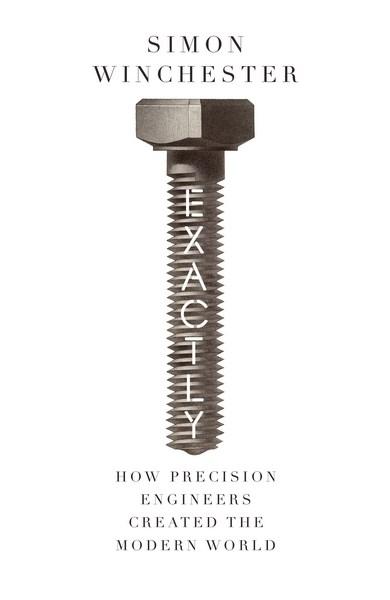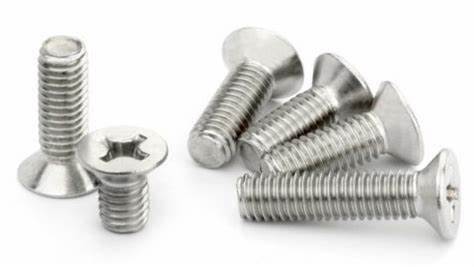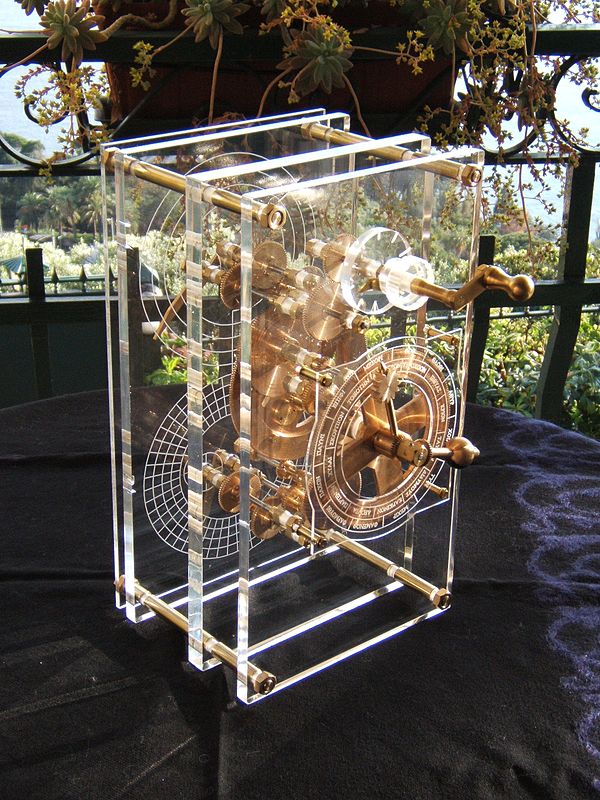It’s one of the most interesting, enlightening and eye-opening books I’ve ever read: Simon Winchester’s Exactly: How Precision Engineers Created the Modern World (2018). Winchester tells a story of astonishing ingenuity, intelligence and effort from the steam-engine (44) to the “extreme ultraviolet” laser (296). And it’s almost exclusively a story of stale pale males—of White men from northwestern Europe. They’re the ones who have created the modern world, whether living on ancestral soil, like the English ironmaster John Wilkinson (1728–1808) and the Swedish machinist Carl Edvard Johansson (1864–1943), or transplanted to the United States, like the manufacturer Henry Ford (1863–1947) and the space scientist Roger Easton (1921–2014).

Pale precision: the front cover of Simon Winchester’s Exactly (2018)
Logocentric lawyers vs exotropic engineers
If only one of those names is familiar to you, then you’re not alone. Before I began this book, I had heard of James Watt, John Harrison, Henry Ford, Sir Frank Whittle and “Rolls-Royce.” And that was pretty much it. Although precision engineering has shaped the lives of every human being on the planet (with the rare exception of stone-age tribes like the Andamese Islanders), precision engineers have not usually become household names. That’s partly because engineers in general aren’t interested in becoming household names. Instead, they’re interested in engineering, in solving technical problems, in overcoming the challenges posed by gravity or heat or cold or drag or pressure or vibration or chemical attack or any combination thereof.

The joys of Jewish ideology: a satirical diet-ad about the famines caused by communism
But the anonymity of engineers is also partly due to what you might call the logocentric snobbery of Western culture. As Ron Unz has pointed out, the typical training for a Western leader is that of lawyer, while the typical training for a Chinese leader is that of engineer. This may give China a decisive advantage over the West in the century ahead. Or rather, it may give China another decisive advantage, because China’s racial majority, the Han Chinese, is not under ideological and demographic assault by a hostile elite of Jews and by non-Chinese immigrants eagerly applying the Jewish culture of critique. There would be plenty of material in China for a hostile elite to work with — the brutal subjugation of the Tibetans and Uighurs, for example — but the Chinese don’t intend to surrender control of their homeland to anti-Chinese outsiders. They’ve suffered the calamities of Jewish ideology all the same. Marxism has afflicted them with famines, concentration camps and a high-tech surveillance state, but they remain unrepentant in their ethnocentrism and probably unstoppable in their eugenics.
“The west was built on racism”
Things are very different in the West. Shortly after completing my latest re-read of Simon Winchester’s book, I came across two articles in the Guardian celebrating the work of Kehinde Andrews, the “first UK professor of Black studies.” Professor Andrews claims that he’s “probably done permanent damage to [his] mental and physical health establishing this Black studies course [at Birmingham City University].” But fear not: the sacrifice of his Black body and Black brain has not been in vain. Professor Andrews has spoken harsh truth to hegemonic power and established that “the west” (no capital letter, naturally) “was built on racism” — “that the US was created ‘in the founding fathers’ image of white supremacy’ and Britain’s wealth accumulated through centuries of African enslavement.”

Speaking harsh truth to hegemonic power: Black Studies Professor Kehinde Andrews (who is part-White)
Well, you can be sure that there are no anti-Chinese or anti-Jewish equivalents of Kehinde Andrews in Chinese or Israeli universities. And you can also be sure that Professor Andrews is even more ignorant about engineering than I am. Yes, Britain did indeed accumulate some wealth “through centuries of African enslavement.” But so did the Muslim world and African slave-kingdoms. And slavery was neither necessary nor sufficient for the rise of Britain as an industrial and technological giant. Black slaves effectively played the role of horses and oxen: their muscles powered mechanisms and economic systems created by White ingenuity and foresight, but Blacks had no intellectual or creative role in what they powered.
White men aren’t obsessed with themselves
And “racism” does not explain why White men were necessary (and would have been entirely sufficient) for the creation of precision engineering. But evolution and genetics do, as Kevin MacDonald has described in books like Individualism and the Western Liberal Tradition: Evolutionary Origins, History, and Prospects for the Future. Nevertheless, Kehinde Andrews exposes one half of what I call the pale male paradox. White men have achieved most in all manner of fields, from engineering and mathematics to exploration and mountaineering. But they are also the most vilified group on earth and are held responsible for all manner of evils, from slavery and pollution to systemic racism and police brutality. Why does the highest-achieving group also receive the greatest opprobrium? That seems like a paradox, but I’d suggest it’s easy to resolve. The same factors behind the achievements of White men also explain the vilification of White men.
High amongst those factors is the fact that White men aren’t obsessed with themselves and their own interests. Simon Winchester himself is a good example. I could detect no trace of racial or national pride in Exactly. He didn’t write the book as a White man to celebrate the greatness of White men: he wrote it because he delights in engineering and ingenuity. More generally, you could say that he delights in external reality and humanity’s efforts to understand and control it — he’s written books about everything from maps and skulls to earthquakes and the Pacific Ocean. But he isn’t an autistic technophile and although he describes the astonishing achievements of Henry Ford in Exactly, he also begins the book with a series of quotations from the technocritic Lewis Mumford (1895–1990), including the line: “Forget the damned motor car and build cities for lovers and friends.”
Not interested in truth or reality
And he ends the book celebrating both the precise technology and the imprecise artistry of another group of pale human beings: the Japanese. He describes how, in Japan, meticulous electronic engineers co-exist with craftsman devoted to “wabi-sabi, an aesthetic sensibility wherein asymmetry and roughness and impermanence are accorded every bit as much weight as the exact, the immaculate, and the precise.” (p. 314) In other words, Winchester is objective and able to understand opposing ideas and points of view, quite unlike the rabidly ego- and negro-centric Kehinde Andrews. And Winchester is highly intelligent and scientifically knowledgeable, again unlike Kehinde Andrews.
Winchester and Andrews are therefore excellent representatives of their respective races: over-achieving, gift-bestowing Whites and under-achieving, grievance-bearing Blacks. Furthermore, Winchester trained as a geologist and has worked with advanced engineering. He’s a writer who’s rooted in reality. Kehinde Andrews isn’t rooted in reality, which you might suppose a fatal disadvantage for a historian and cultural commentator. But Andrews’ career flourishes regardless, because the culture of critique is not interested in truth or reality. Instead, it is interested in political and social power. It’s effectively an ideological parasite that has, so far, done an excellent job of subverting the nervous system of the West and taking control of its economic, technological and cultural muscles. That’s why the Black drug-abuser and criminal George Floyd is vastly better known than, for example, the White engineer Henry Maudslay (1771–1831).
Screw you, BLM!
Again, I hadn’t heard of Maudslay and his “formidable skill in delicate engineering” (p. 54) before I read Exactly. Unlike George Floyd, Maudslay exerted himself to defeat crime, not to commit it. He helped perfect the effectively unbeatable locks of his mentor Joseph Bramah (1748–1814). He then went on, in Simon Winchester’s words, “to become the founding father of precision toolmaking, mass production, and the key engineering concept of perfect flatness.” (p. 62) Among much else, he invented a lathe that could “efficiently, precisely and [quickly]” make something that contributed far more to Britain’s wealth than “centuries of African enslavement.”

The humble but hyper-important screw
What was the something? It was “that most essential component of the industrialized world, the screw.” (p. 63) Henry Maudslay, unlike George Floyd, helped hold the Western civilization together — and literally so. In a sane world, his story would embolden Whites to say “Screw you!” to inane and self-righteous anti-White groups like Black Lives Matter. But we don’t currently live in a sane world. Maudslay was an undoubted achiever, Floyd was an alleged victim. And the culture of critique “valorizes” Black victims while anathematizing White achievers. That’s why most of us heard endlessly about Floyd in 2020 and not at all about Maudslay.
Horrific hate-crimes against the Jewish community
Nor did we hear about a Swedish engineer who contributed immensely to perhaps the most important part of precision: measurement. But Winchester points out that the Swedish engineer has been unjustly forgotten for a long time: “Carl Edvard Johansson died in 1943, respected and beloved in Sweden, and forgotten elsewhere.” Johansson (1864–1943) invented measuring instruments known as gauge blocks or Jo blocks, which come in varying sizes and can be fitted together to measure, for example, “any of the 1000 lengths from 3.000 to 3.999 mm in 0.001 mm steps.” Winchester writes that Jo blocks are “machined with such precision that there [are] no asperities whatsoever on their surfaces that might allow air to get between and form a point of weakness. They [are] so perfectly flat that the molecules of their faces [bond] with one another when they [are] joined [and it becomes] impossible to break them apart. … They can only be slid apart.” (p. 3)
Winchester adds that scientists still don’t fully understand the physical mechanism behind the bonding of Jo blocks. In a sense, White ingenuity is still defeating White ingenuity: Johansson’s measuring blocks created a mystery. But another mystery was vigorously probed by the man who employed Johansson after he moved to America. That man, Henry Ford, is perhaps the most interesting and important figure in Exactly. Winchester cleverly contrasts Ford’s success in mass-manufacturing and popularizing the motor car with the elitist engineering and marketing of the Rolls-Royce partnership in England. But he doesn’t say anything about one horrific aspect of Ford’s story: his prolonged hate-crimes against the Jewish community.
Cohesive, in-bred and hyper-ethnocentric
As Kevin MacDonald has described in “Henry Ford and the Jewish Question,” Ford devoted substantial time and money to the mystery of how the tiny Jewish minority has been so influential in — and pernicious for — the Western world. He backed a newspaper, The Dearborn Independent, that tried to alert gentile Americans to what Ford saw as Jewish conspiracies against the West. And he published an infamous book called The International Jew: The World’s Foremost Problem (1920), which MacDonald describes as “an amalgam of dark speculations on Jewish conspiracy combined with some interesting and, on the whole, accurate information on Jews and perceptions of Jews during the period.”
It’s plain today that Ford succeeded mightily at mechanical engineering and failed miserably at social engineering. His attempts to expose Jewish conspiracy and defeat Jewish power were fruitless, but that’s hardly surprising. Like the other engineers and inventors in Exactly, Ford was a remarkable White male individual, not part of a cohesive, in-bred Jewish community bound by hyper-ethnocentrism and the ruthless pursuit of collective interests. White men are certainly remarkable for their ability to cooperate, but not in pursuit of their own ethnic and genetic interests. Instead, they direct themselves outwards, creating ingenious and awesome machines, scaling the earth’s heights, plumbing the ocean’s depths, and landing in person or by proxy on the Moon, Mars and Venus.
All Blacks Who Ever Lived
If the minds of White men weren’t directed outwards like that, they wouldn’t be so vulnerable to parasitic ideologies like the culture of critique and Critical Race Theory. But White men also wouldn’t have achieved astonishing things like those described in Simon Winchester’s book. So is it ironic that Kehinde Andrews and countless other anti-White ideologues go through life relying absolutely on White male invention and ingenuity without acknowledging the debt they owe, let alone expressing any gratitude? No, I don’t think it is. I think it’s entirely predictable. One could hardly expect Kehinde Andrews to admit that merely one tiny White group like the Swedes have contributed more to science and technology than all Blacks who ever lived.
Indeed, the single Swedish male Carl Edvard Johansson contributed more to science and technology than all Blacks who ever lived. As did each of the other stale pale males described in Simon Winchester’s Exactly: How Precision Engineers Created the Modern World. Winchester didn’t write this book to refute the culture of critique and the inanities of “anti-racism,” but I think it provides a highly effective refutation all the same. It wasn’t written as a celebration of White male achievement and in fact I didn’t impose that interpretation on it as I read. After all, I’m a White male myself and like Winchester I can rejoice in engineering and ingenuity for their own sake.
“A work of staggering genius”
And Winchester also speculates whether the Industrial Revolution could have happened more than two thousand years ago. He begins the first chapter of this book writing about the Antikythera mechanism, a “lump of calcified bronze and wood” (p. 24) recovered from a shipwreck in the Mediterranean in 1901. It turned out to be “a mysterious computing device of unimagined mechanical complexity … that had evidently been made in the second century B.C. and was clearly a work of staggering genius.” (p. 25) It was White genius, but not in northwestern Europe, but the product of another incredibly talented European group, the ancient Greeks. And why did that genius not bear greater fruit? At the moment we can only speculate, but cliodynamics and historical genetics may soon be able to tell us why Exactly was published in 2018 and in English, rather than two millennia ago in Greek or Latin.

A work of staggering genius: the 2100-year-old Antikythera mechanism, an ancient Greek analogue computer and orrery used to predict astronomical positions and eclipses for calendar and astrological purposes (modern reconstruction)
If the Industrial Revolution had indeed started in the Ancient World, White men might have reached the stars by now. It didn’t and it’s the Chinese who seem best-placed to carry on the legacy of the White engineers described in Winchester’s book. Unless White men start devoting some of their genius to the problem of self-defence, they won’t have a future. Or even perhaps a past. The culture of critique is already proclaiming that Black women “played a crucial part” in the Moon Landings and the creation of GPS, the global positioning system whose genuine White male creators are described in Winchester’s book.
Proud Black wimminz in, hate-filled honkies out
As Black women are written into the history of STEM (Science, Technology, Engineering and Mathematics), White men will be written out. Our hostile elite aren’t really following the script of Orwell’s Nineteen Eighty-Four (1949), but they might as well be: “In his own schooldays, Winston remembered, in the late fifties, it was only the helicopter that the Party claimed to have invented; a dozen years later, when Julia was at school, it was already claiming the aeroplane; one generation more, and it would be claiming the steam engine.”
The steam engine, the aeroplane and the helicopter are all products of White male genius. The parasitic Party had already claimed two of them for its own in Orwell’s novel. In our reality, the parasitic culture of critique is beginning to assign the products of White male genius to Black women. That’s false history, but lies power leftism and it’s precisely because White men have flown so high that the culture of critique intends to bring them so low. Simon Winchester’s Exactly: How Precision Engineers Created the Modern World describes the heights of White male achievement and serves as an excellent, if implicit, refutation of the anti-White ideologies now infesting and undermining the West.